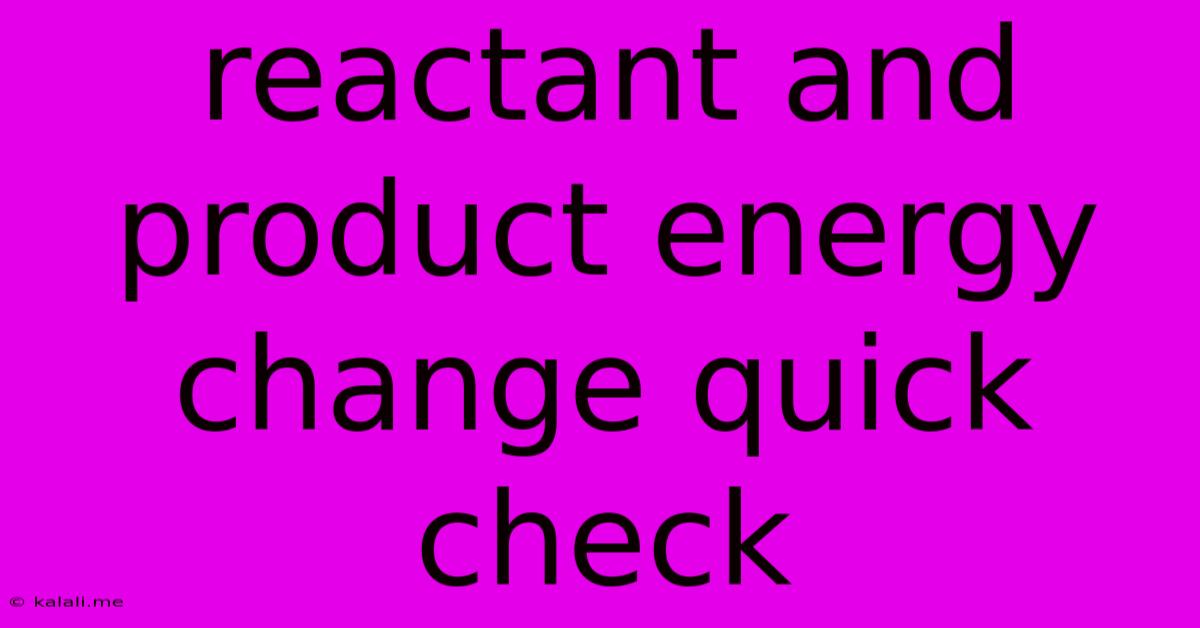Reactant And Product Energy Change Quick Check
Kalali
May 10, 2025 · 3 min read

Table of Contents
Reactant and Product Energy Change: A Quick Guide
Understanding the energy changes that occur during a chemical reaction is fundamental to chemistry. This quick guide will clarify the relationship between reactants, products, and the energy involved, focusing on exothermic and endothermic reactions. We'll explore how to visualize these changes using energy diagrams and delve into the concepts of activation energy and enthalpy change. This information is crucial for anyone studying chemical reactions and their energetics.
What are Reactants and Products?
Before diving into energy changes, let's quickly define the key players:
- Reactants: These are the starting substances in a chemical reaction. They are the ingredients that will be transformed.
- Products: These are the substances formed as a result of the chemical reaction. They are the outcome of the transformation of the reactants.
Exothermic vs. Endothermic Reactions
The energy change during a reaction is categorized as either exothermic or endothermic:
-
Exothermic Reactions: In these reactions, energy is released to the surroundings. The products have lower energy than the reactants. Think of burning wood – it releases heat and light. This is an example of an exothermic reaction. Key characteristics include:
- Release of heat (increase in temperature of surroundings)
- Negative enthalpy change (ΔH < 0)
- Products are more stable than reactants
-
Endothermic Reactions: In these reactions, energy is absorbed from the surroundings. The products have higher energy than the reactants. Photosynthesis is an example of an endothermic process; plants absorb energy from sunlight to convert carbon dioxide and water into glucose and oxygen. Key characteristics include:
- Absorption of heat (decrease in temperature of surroundings)
- Positive enthalpy change (ΔH > 0)
- Products are less stable than reactants
Visualizing Energy Changes: Energy Diagrams
Energy diagrams provide a visual representation of the energy changes during a reaction. They typically show the energy of the reactants, the energy of the products, and the activation energy.
- Activation Energy: This is the minimum amount of energy required to initiate a chemical reaction. It's the "energy barrier" that reactants must overcome to transform into products.
Enthalpy Change (ΔH)
Enthalpy change (ΔH) quantifies the overall energy change of a reaction. It's the difference between the enthalpy of the products and the enthalpy of the reactants.
- ΔH = H<sub>products</sub> - H<sub>reactants</sub>
A negative ΔH indicates an exothermic reaction, while a positive ΔH indicates an endothermic reaction.
Examples of Reactant and Product Energy Change
Let's illustrate with simple examples:
-
Combustion of Methane (Exothermic): CH₄(g) + 2O₂(g) → CO₂(g) + 2H₂O(l) + Heat. In this reaction, methane and oxygen react to produce carbon dioxide, water, and heat, signifying a release of energy.
-
Decomposition of Calcium Carbonate (Endothermic): CaCO₃(s) + Heat → CaO(s) + CO₂(g). This reaction requires heat input to break down calcium carbonate into calcium oxide and carbon dioxide.
In Conclusion
Understanding reactant and product energy changes is essential for grasping the fundamentals of chemical reactions. By recognizing the differences between exothermic and endothermic processes, visualizing energy changes using diagrams, and understanding the significance of activation energy and enthalpy change, you can gain a more comprehensive understanding of chemical thermodynamics. Remember to consider the energy involved when analyzing any chemical reaction.
Latest Posts
Latest Posts
-
What Is Half Of 1 4 Teaspoon
Jul 02, 2025
-
How Many Cups In A Pound Of Hamburger Meat
Jul 02, 2025
-
Imagery Or Figurative Language From Romeo And Juliet
Jul 02, 2025
-
What Is A Quarter Of A Million
Jul 02, 2025
-
Which Of The Following Is True Concerning A Dao
Jul 02, 2025
Related Post
Thank you for visiting our website which covers about Reactant And Product Energy Change Quick Check . We hope the information provided has been useful to you. Feel free to contact us if you have any questions or need further assistance. See you next time and don't miss to bookmark.